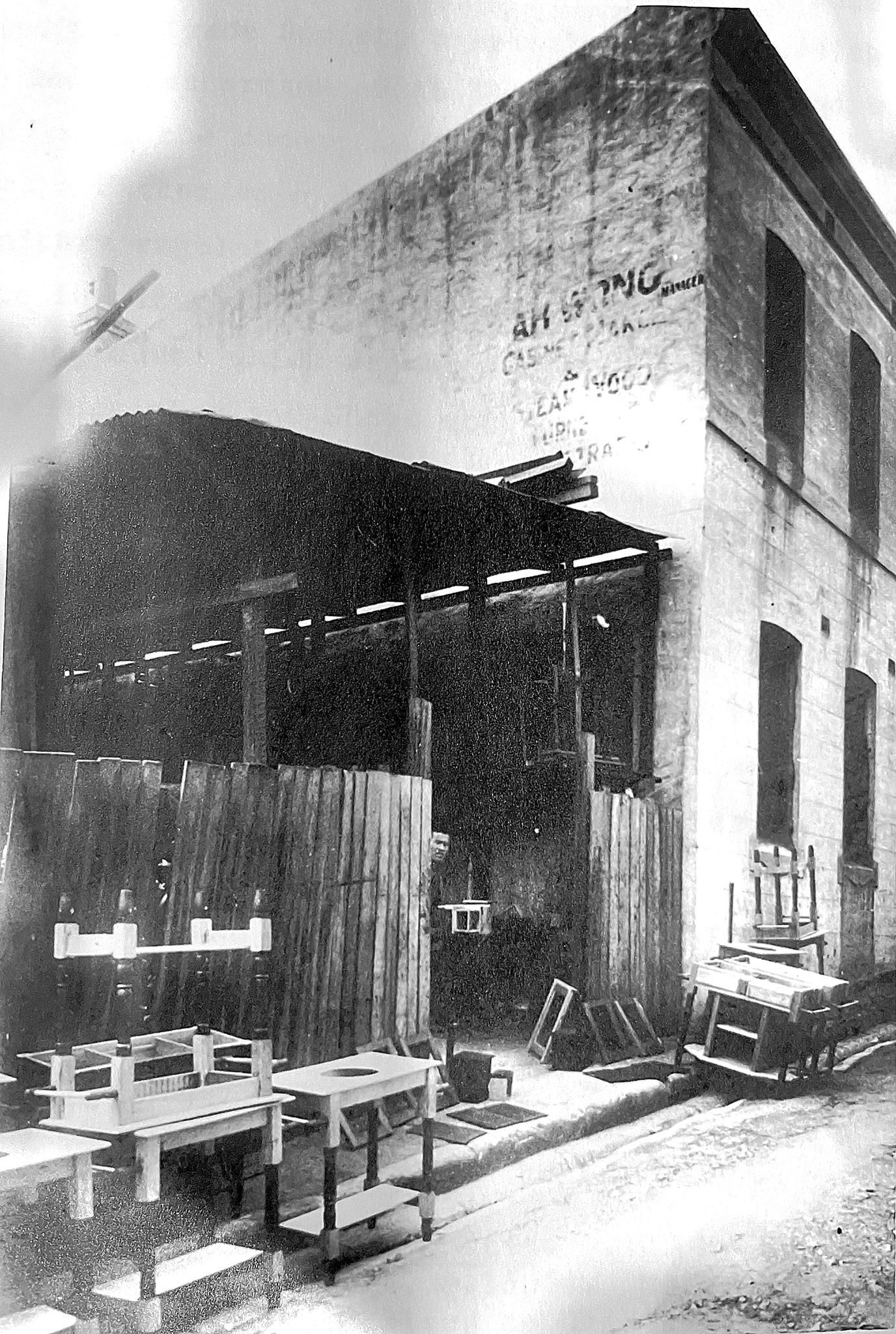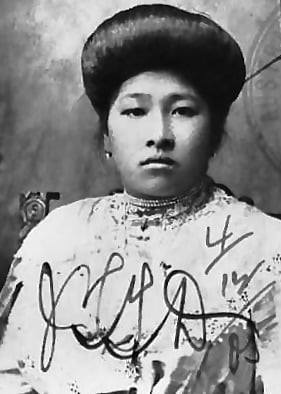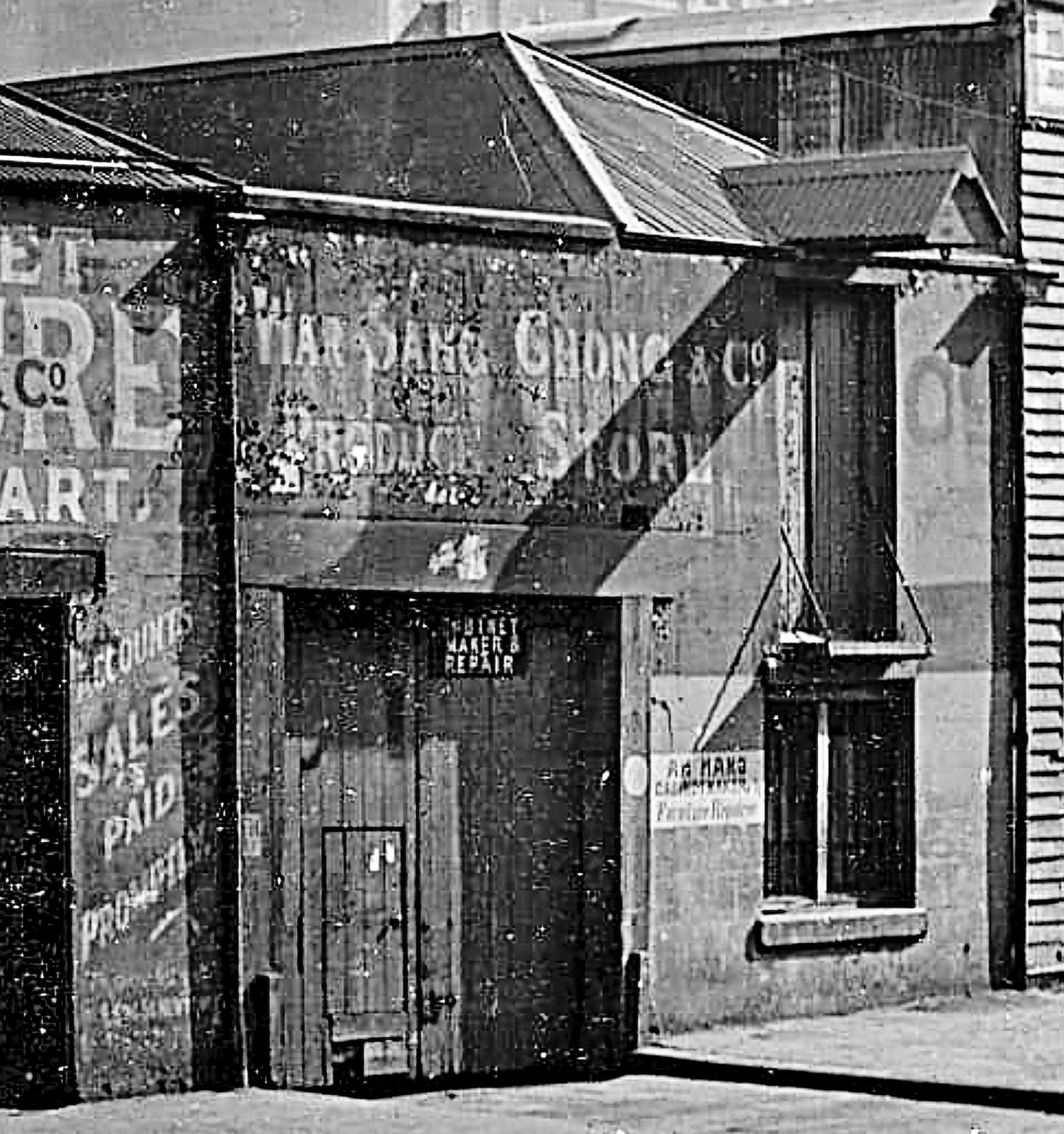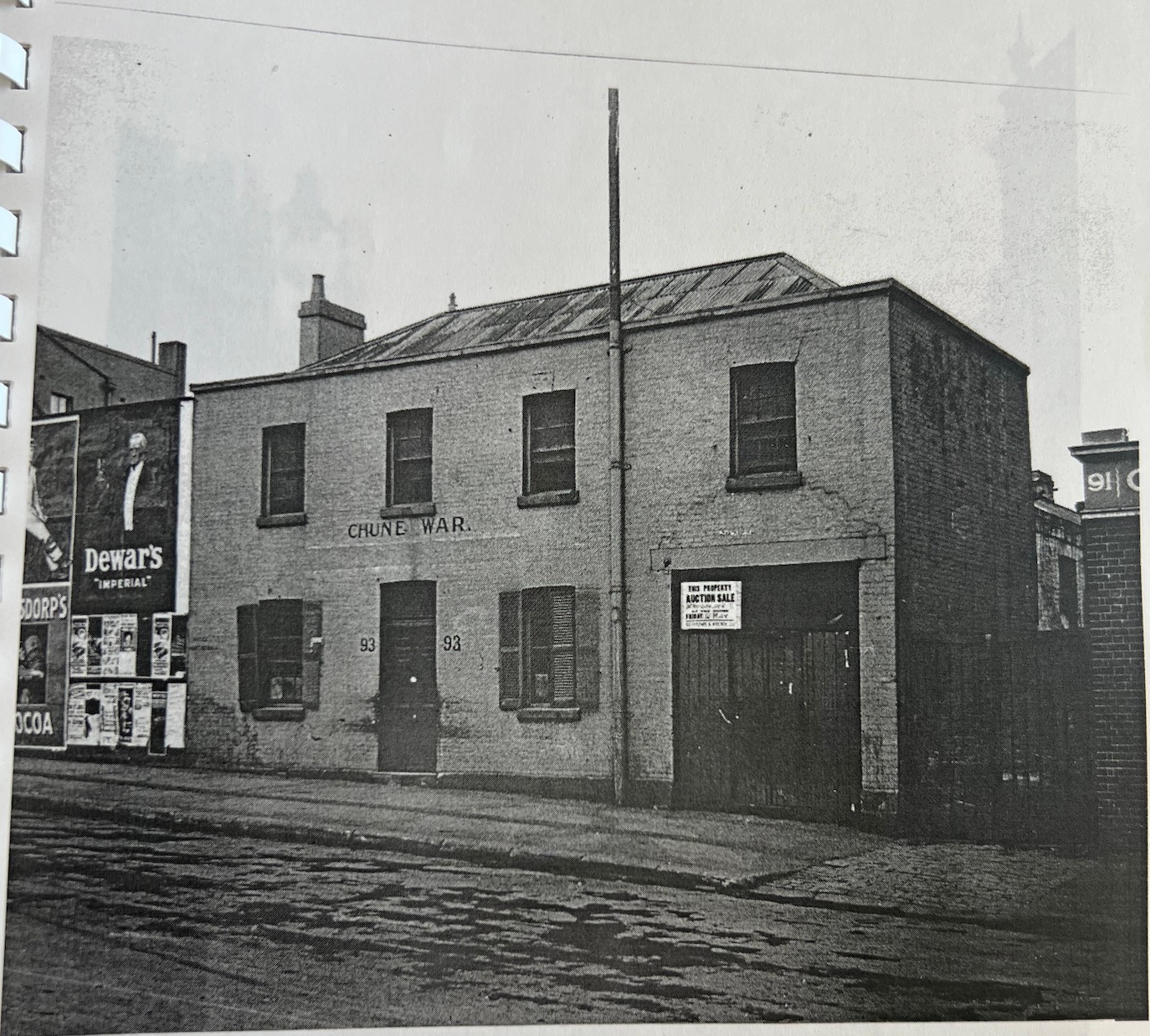Ah Wong's cabinetmaking work shop with wash stands and other products for sale outside on the pavement
John Hoe was a prominent 20th century Sydney furniture designer and maker working from factory buildings in Waterloo. Hoe was a leader against the furniture manufacturing interests's attacks on Australasian (mostly Chinese) furniture makers and a regular exhibitor with the NSW Furniture Guild with photographs in the SLNSW.
Evening News (Sydney, NSW : 1869 - 1931)
Wed 8 Jul 1908 Page 3
THE CHINESE MYSTERY. Mr. John Hoe. writes:— I trust you will grant
Mr. John Hoe. writes:— I trust you will grant
me sufficient space in your paper to reply to iUe.
following part, which appeared in your leading
article of Monday, 6th instant:— 'Nevertheless,
they are not aggressive; industry and economy
are as second natures to them; they also have
their uses in the. community. All the same, it
seems an impossibility to compel them to act in
accordance with the usages of the community of
which they are not a part, but rather an excre
sence on its surface. The Chinese ask merely to
be let alone, allowed to go their own way, follow their own pursuits, live their own lives free
from interference. In such event, they can be
thoroughly trusted to proceed along toe lines of
least resistance, as they have, ever done, and are
now doing. But this to their mind ideal sort of
existence can by no means be permitted. That
there can be one law for Chinese and another for
Europeans is quite out of the question.'
We. admit that the Chinese of this State desire
to be left alone, conditionally; that they conform
to the laws now prevailing. The only time we
have publicly protested in any way was when the
enemies of the Chinese have, and are now trying
to induce the Government and Parliament of this
State to have a special and not a general law enacted towards them.
I am not speaking advisedly when I make this
accusation. The proposed Victorian Factory
Act is one of the most inhuman and unchristian Acts that was ever invented by those who
assign to themselves that they are Christians
and humanitarians. Here it is, as it was rejected by the Legislative Council of Victoria
after the Council of Churches protested against
it on the grounds that it was a disgrace to
Christian civilisation: — 'No Chinese person;
whether an employer or employee, shall, after
the first day of any month named by the authorities, work, or be employed in any factory
or workroom; unless such Chinese person holds
a licence authorising him to work or be
employed.'
Let any person that chooses to be just put
himself in the place of a Chinese, and analyse
it, he will then see the many disabilities in
it. For instance, a Chinese may be ill or
absent, from a variety of ways may not be
working during the month nominated for his
registration; he may be on a visit to see his
relatives in his native land. Just because he
should be absent at the time requested by the
authorities, he is to be made a pauper immediately, notwithstanding__the fact that they
have qualified themselves for this particular
work by years of toil and industry, but simply
because they did not happen to be in a factory
at work in the month to be named, they are to
be forever excluded from making a living in
this particular industry.
I ask any Christianised or humanised person
if it is possible for human prejudice to go further by violating ,the 'live and let live'
policy? The political party now identified
with this anti-Chinese clique I cannot under
stand; their objective, I believe, at all times
is to uplift and not to crush. They recently
protested, against His Majesty the King of England visiting Russia, on the grounds that he
was visiting the land of oppression. But what
do we find? These same individuals who are
raising their voice in protest, trying to enact
similar, if not worse, laws against a people
who in their own hearts know are politically
helpless to retaliate. I have no hesitation in characterising their
view for the uplifting of common humanity
as a piece of unblushing hypocrisy. There is
no more excuse for oppressing the Chinese
than there was for the Russians carrying on
the highly civilised pastime of Jew baiting,
massacring, and mutilating men, women, and
children on account of their religion. Why
should these assumed humanitarians ask for
legislation against Chinese tradesmen, who
have proved themselves good workmen, thrifty,
and law abiding? We are like men of all
other races; we have vices, but this hue and
cry against us is not aimed at our vices, but
for our virtues. Much capital is made out of
this remarkable fact, that we are not willing
to assimilate, that we have not the same aspirations and ideals as the Australians! When
we make an effort to do so, they hold us at
arms length, and throttle us for attempting
to do so.
Some time ago the Chinese carpenters of this
State had some misunderstanding with their
masters on the principle of trade unionism. In
order to achieve victory they wanted to become members of the European Cabinet Makers
Union, but the union officials, as reported in
your paper, absolutely refused to accept them
as members, on the ground that 'East is East
and West is West, 'and never the twain meet'
If the prejudice of the officials had not dazed
their sense of fairness, there would not be any
room for the cry of special legislation dealing
with the Chinese.
Chinese gardeners, tradesmen, and cooks
have now learned that they are economically
equal to other men of other races, and their
ideas of equality assert themselves, first of all
— in their charging as much as other men, as
much as our general economic laws of supply
and demand permit. We all realise Australian affiation and assimilation are the deadliest
foes of starvation wages. The Chinese have
no desire to underbill Australian, labor, they are
willing to join the labor unions, and thus uphold the dignity of Australian labor.
The better class of Chinese have no sympathy
for lawbreakers; on the contrary, they are in
favor of very rigid execution of the laws, and
that if found guilty of any crime or misdemeanor, that they shall be severely punished
according to the law.
In conclusion I may state we object to no
law that is for the benefit and welfare of the
community at large, that is based on equity
and justice, and is uniform in its application.
We intend to oppose all special laws aimed at
the Chinese, and quite agree with you, quoting
your own words, 'that there can be one ' law
far Chinese, and another for Europeans, is quite
out of the question. For this principle we
are fighting, and only laws based on such a
principle can be respected and enforced.
PLATE 30*
Rear of 432 Sussex Street in 1900. This shows the covered yard and assorted additions at the back of adjoining shops at 430-432 Sussex Street. Various Chinese cabinetmakers had been renting one or both of these buildings as a factory since they were built in 1889. The Chinese man on the roof probably worked for Sun Tong War and Co., cabinetmakers, who occupied 430 Sussex Street in 1900. Their timber is drying on the roof of the yard behind him.
*in Janice L. Wood's 1994 B.A. Hons Thesis CHINESE RESIDENCY in the HAYMARKET and SURRY HILLS 1890 -1902.


PLATE 18*
Chune War's cabinetmaking factory was at 93 Goulburn Street from 1891, but before that Tack Lee ran a cabinetmaker's business at the same address. As early as 1875, the houses at the back of the building seen here, known as Smith's buildings, had been home to a number of Chinese. In 1891, the front of this property was a gambling house, while 22 cabinetmakers lived and worked at the back
(Chinese Gambling Commission., Police Return of Chinese Premises).
*of Janice L. Wood's 1994 B.A. Hons Thesis CHINESE RESIDENCY in the HAYMARKET AND SURRY HILLS 1880 to 1902.
 detail showing a cabinetmaker on the War Sang Chong, produce merchants premise
detail showing a cabinetmaker on the War Sang Chong, produce merchants premise
Chune War's cabinetmaking factory was at 93 Goulburn Street from 1891, but before that Tack Lee ran a cabinetmaker's business at the same address. As early as 1875, the houses at the back of the building seen here, known as Smith's buildings, had been home to a number of Chinese. In 1891, the front of this property was a gambling house, while 22 cabinetmakers lived and worked at the back
(Chinese Gambling Commission., Police Return of Chinese Premises).
*of Janice L. Wood's 1994 B.A. Hons Thesis CHINESE RESIDENCY in the HAYMARKET AND SURRY HILLS 1880 to 1902.

CHINESE AUSTRATIAN FURNITURE MAKERS, I87O-I 930 Peter Cibson
a vital stake in Australia's fumiture industry. Operating chiefly in Sydney and Melbourne as part of a broad economic diversification by Chinese migrants after the gold rushes of the 1850s and 1860s, they rivalled their European counterparts for primacy in Australianfumiture production. At numerical peak in 1912, there were approximately 200 Chinese furniture factories with close to 2,000 Chinese workers Australia-wide. This made furniture manufacturing the most important post-rush Chinese economic activity inAustralia next to agriculture, and one of the largest employers of Chinese migrant workers (Gibson 2017: 99).
Chinese Australian furnifure manufacturers and workers originated in Guangdong's Pearl River Delta counties. Grangzhou, or Car-rtory in the upper reaches of the De1t4 had been a manufacturing centre of products for Western export since the 17th century, and had enjoyed an officially sanctioned monopoly on China'sforeign trade. Various goods-including porcelairl silverware, lacquerware, silken fabric and furniture-were produced here for sale on European and, 1ate4, North American and Australian markets.
Yet this commercial activity was declining during the 19th century. Critical catalysts were European and American industrialisation and the Treaty of Nanjing, imposed upon China by Britain to conclude the First Opium War (1839- 42), which forced open a number of Chinese ports to foreign trade and ended Guangzhou's monopoly. The Treaty also facilitated the migration through Hong Kong of thousands of Cantonese gold seekers to California and Australia from the 1850s onwards, some of whom then went on to become involved in the Australian furniture industry Australia, where industrialisation came late and imports ,of manufactured goods could not meet demand, had to increase its domestic furniture output. Chinese Australian manufacturers and workers, carrying on a long rich hadition of furniture production in Guangzhou and its environs, responded to this need.
In Australia, Chinese furnitme makers employed time-honoured Chinese practices. This is evident in furniture like the Chinese chair made in Victoria around 1870 in the collection of the Art Gal1ery of South Australia. Cralted in red cedal blackwood
and bone, the chair features clear elements of classical Chinese furniture design. The chair is a 'southern officiai hat chair' (nan guan mao vi), poprlar throughout southern China in the 19th century and has features of other classic styles, notably the'rose chau' (meigui yi) and 'official hat chair' (6uan mao yl). It is carvedwith the'thunder pattern' (lei wen).
Historians Kevin Chamberlain and Ian Jack have identified similar pieces, although the whereabouts of these items is unknown. To make such furniture, woodworkers often used tools of the Cantonese traditio& examples of which are on display in Melbourne's Chinese Museum and in theMuseum of the Former Residence of Sun Yat-sen in Zhongsharr, Guangdong. Wielding these tools sometimes required use of both hands and feet, a technique that was illustrated-along with distinctive bowsaws and sloped workbenches-in an 1BB0 sketch of a Melbourne Chinese furniture factorv.
Chinese Austr.alian furniture makers also honoured the ancient Chinese woodworker and god, Lu Ban. Born around the same time as Confucius, approximately 500 BCE, Lu Ban is believed to have constructed formidable wooden siege engines and sophisticated automata. Seen as the embodimert ol qiao (ski11), Lu Ban was later deified and revered both within China and among Chinese overseas migrant woodworkers (Ruitenbeek 1993: 15-24). Chinese furniture industry participants in Australia celebrated Lu Ban Day on the 13th of june with the day off from
work, banqueting, calligraphy exhibitions and performances of Cantonese opera.
Despite the continuation of long-established Chinese woodwork practices in Australia Chinese furniture manufacfurers and workers were more directly influenced in their activities by trends in European Australian retailing and consumerism. Chinese (actories tended to sell most of their fumiture to major retailers- Anthony Hordem and Sons, David Jones, Myer-who ordered pieces made using designs inspired by the latest London and Paris styles.
Retailers supplied Chinese manufacturers with pattern books, and regularly provided the same designs to different furniture factories, Chinese and Europeary pitting them against each other in efforts to keep prices low for themselves (Gibson forthcoming 2019). One known example is a dressing table made by the Wing Lee Brothers factory in Melbourne in the early 20th century, now held in the Golden Dragon Museum in Bendigo. Its style is consistent with the conservative European Australian retail environment of this era, bearing none of the embellishments of the 'southern official hat chair'. There arecomparable objects made in European styles held in Melbourne's Chinese Museum and in private collections. Along with completed items of furniture, it was also common for Chinese furniture factories to produce components for European manufacfurers, and to incorporate European-made componentsinto their pieces, resulting in Chinese- European hybrid fu rniture.
CHINESE FURNITURE MAKERS. LITTLE BOURKE STREEI, 24 APRIL ] 880, ARTIST UNKNOWN, MELBOURNE, PRINTED THE AUSIMTAS/AN SKEICHER, STATE LIBMRY OF VICTORIA PRINT
TAASA REVIEW VOLUME 28 NO.3
CHINESE LABOUR STAME EARTY 2OTH CENTURY WING LEE BROTHERS, MELBOURNE, GOLDEN DRAGON MUSEUM, BEND GO, PHOTO COURTESY OF LEIGH MCKINNON
ARMCHAIR C, ] 870, CH NESE CAB NET MAKER, TERRINALLUM STATION, DARL NGTON, V]CTORA, AUSTR,{LIAN RED CEDAR, AUSTMLIAN BLACKWOOD, BONE, ] OO.8 X 65,4 X 53.5 CM, ART GALLERY OF SOUTH AUSTMT A, SOUTH AUSTMLIAN GOVERNMENT GRANT ] 989
Chinese factories sourced most manufacfuring necessities from European Australians. Timber for Chinese factories-Australian and North- American varieties for the most part-came almost entirely {rom European Australian timber dealers, and other materials such as glass, glue, nails, screws, marble and shellac also came from European Australian suppliers. Most tools and machines were sourced from non-Chinese hardware and machine merchants, too, and many Chinese manufacturers outfitted factories with the latest technology from the late 19th century. This included hydraulig gas, oil and steam-and then later direct-andalternating-current electric-lathes, circular saws, bandsaws, plalers, mortisers and tenoners (Gibson forthcoming 2019). European machinists were often hlred to operate these machines or coach Chinese workers in their use, challenging the artisanal legary of Lu Ban in what many Chinese factory bosses saw as an essential drive towards'modernity' (Gibson 2077: 706). Furniture production in Australia typically meant that Chinese fumiture makers had to adapt themselves to unfamiliar artistic and commercial milieus.
Due to the high degree of uniformity in the pieces produced in Chinese and European furniture factories inAustralia, the proponents of 'white labour' campaigned aggressively for racialised furniture stamps. They hoped that these would empower consumers of European ancestry to buy'European' instead of 'Chinese' items, thus helping create 'White Australia'. They also aimed to prevent various government departments from surreptitiously purchasing Chinese furniture for government buildings, which was regularly alleged to have taken p1ace, including for Government House in Sydney in 1901. These campaigns were most effective in Melbourne, where 'Chinese labour' and'European labour only' stamps were enshrined in labour legisiation from 1896. A'Chinese labour' stamp on the dressing table manufactured by Wing Lee Brothers in Melbourne is featured.
While confronting, racialised furniture stamps were widely regarded as ineffectual. They encouraged some consumers to bypass major
retailers and buy direct from the factories, and they were not seen in Sydney (Leckey 2003: 33044). Such stamps are the surest means of identifying Chinese furniture made in late 19th and early 20th century Australia. Many Chinese pieces probably survive in Australian antique furniture collections owing to theimportant place of Chinese factories in the furniture industry of the period, though they are difficult to identify without stamps. The number of known pieces of Chinese Australian fumiture in public or private hands is unclea! but is 1ikely to be extremely small.
Chinese Australian furniture production declined from the 1910s and effectively ceased by the mid-1930s. In addition to the difficulties presented by Australia's anti- Chinese immigration restrictions from 1888, and other provisions of racialised industrial legislation, Chinese manufacturers were hindered by market downturns (notably from World War One), limited capital and rising workers' wages (Gibson 2018). From the 1920s, Chinese firms like Simpson Lee & Co. in Sydney also scaled back their manufacturing activlties within Australia and
began importing Chinese-style pieces from China. These imports were bound for Chinese business premises, including Sydnev's Pekin Caf6, and for European Australian consumers with eclectic tastes.
Peter Gibson is o PhD condidote in history ot the University of Wollongong. His thesis is obout Auslrolio's Chinese {urnilure foclories in the lotel 9th ond eorly2Oth centuries- Peier con be conlocted ot pcg33@uowmoil.edu.ou.
REFERENCES
Gibson, P, 201 7. 'Voices of Sydney's Chinese Furniture Fociory Workers, 1 890 1 920', Lobou r History oo. 1 1 2, 99 1 17
Gibson, P, 20,l B. Ausirolio's Bonkrupi Chinese Furniture
Mo nufociu rers, I 880-l 930', Ausiro/io n Economic History Revtew, vol. 58, no. l, 87 I 07
Gibson, P, forihcoming 201 9. 'Mode in Chinolown: Chinese Furniiure Foclories in Sydney ond Melbourne, I 880 I 930'. PhD ihesis, University of Wo longong, Wollongong
Leckey,1., 2003. 'Loq Degroded Broois? lndustry qnd Entrepreneurio ism in Melbourne's Liiile Lon, I 860 I 950', PhD thesis, universiiy of Melbourne, Melbourne
Ruitenbeek, K., 1993. Corpenty ond Building in Lofe lmperial Chino: AS|udy al fhe Fiffeenth Century Corpenter's Monuol Lu Bon Jins Bril, Leiden
TAASA REVIEW VOLUME 28 NO,3
IJ
Vw. I